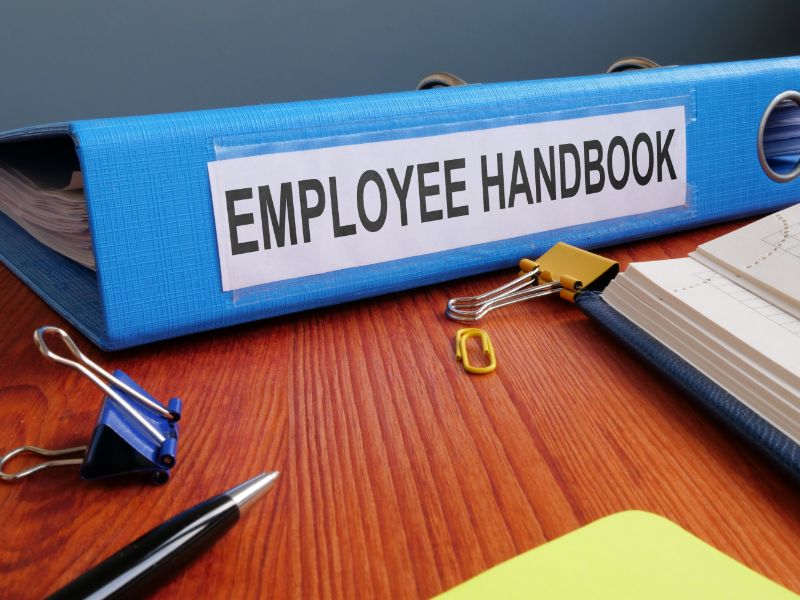An employee handbook shares your mission, policies, values, procedures, expectations, and benefits. It is a vital communication resource that assists with effectively managing your workforce.
Outlining essential policies and the rights of employers and employees helps protect against discrimination and unfair treatment charges. It also limits your legal liability. Although employee handbooks are not required by federal or state law, they can help your organization run more smoothly and efficiently.
Employee handbook benefits
Your employee handbook provides many benefits and allows you to:
- Set expectations: It clarifies what’s expected of your workers and the company. This includes things like safety expectations, timekeeping, and disciplinary procedures that may be enforced in the event of any misconduct. It removes uncertainty and confusion by providing clear guidelines.
- Ensure fair treatment: Consistent enforcement of policies across all departments will demonstrate equal treatment. This will ensure that there are no grounds for claims of unfair treatment by workers.
- Meet compliance requirements: To ensure you meet federal and state regulations, you must include guidelines on anti-sexual harassment and discrimination policies, among others.
- Inform employees of their rights and benefits: An employee handbook ensures that all workers are adequately informed and receive all relevant information about their rights and benefits, such as company holidays, annual leave policies, and benefits eligibility.
- Defend against lawsuits: In the event of legal matters, an employee handbook provides proof that you communicated the required procedures and policies to your employees in writing.
- Improve communication: Opening the doors of communication by creating an employee handbook can assist with promptly resolving any workplace disputes. This is because employees will be familiar with the correct procedures for voicing concerns.
You will need to cover several areas in your employee handbook. Here, we look at the most essential items and why they are important.
Overview of the company mission, values, and objectives
It’s important to include the company’s mission, values, and objectives in your employee handbook. This is because this provides a clear goal for your workers and can help improve their performance.
Besides assisting the employees in seeing the purpose and meaning of their work, it also motivates workers to strive for the company’s long-term aspirations for growth and helps convey your company culture.
Ensuring your workforce is familiar with your company’s values provides staff with a sense of security and guides them in their work. This helps employees make the correct decisions to achieve the company’s vision and goals. Defining clear objectives helps staff to focus and achieve the company’s target. It helps to ensure strategic alignment within the organization and gives your employees short-term goals context, helping everyone stay on the road to success.
Rules and regulations for employees

Setting expectations for all employees allows workers to understand their responsibilities. This includes dress code and cell phone use during office hours. When workers clearly understand what is expected, they also know what they should not ask for. Rules are put in place to ensure a safe and productive workplace. It’s vital to outline employee conduct rules, including company policies on alcohol and drug use. Topics like confidentiality, meals and breaks, ethical standards, and acceptable behavior should also be included. Your employee handbook should also explain your disciplinary policy for conduct violations.
Description of employees’ benefits package
Communicating employee benefits is vital as they have an enormous impact on recruitment and staff retention. Ensuring that your workers are aware of their benefits can help to build trust, ensure loyalty, drive employee education, and reduce the chances of misunderstandings.
A great benefits package shows that a company cares about its workers. When employees are aware of their benefits, such as workplace perks, wellness programs, tuition reimbursement, and paid time off, they feel valued.
This leads to loyal workers who are happy in their jobs and are performance-motivated.
Guidelines for attendance and punctuality
To avoid misunderstandings, it is crucial to ensure that all employees are familiar with the company’s expectations regarding attendance and punctuality. Communicating clear guidelines helps ensure that employees are there when needed and that nobody is taking unfair advantage of the company’s policies surrounding paid time off. Once workers have the handbook, there is no excuse for failing to attend work regularly and not arriving on time. This is extremely important, as adhering to these guidelines will maintain employee morale and productivity.
Policies on dress code, social media use, and acceptable internet use
Some companies need policies regarding dress codes and acceptable social media and internet usage for staff. We’ll break these down and look at them one by one.
Dress code
One of the ways your company culture will be reflected is by the dress code. You will have expectations regarding the image you want your company to convey, and employees are expected to adhere to the desired image. The company dress code communicates what you consider appropriate work attire to your employees.
In some cases, like where employees wear a uniform, it makes staff easy to identify, allowing customers to see at a glance that the worker is a member of your business. Dress codes and professionalism go hand-in-hand.
Social media use
While using social media in the workplace can benefit your company, employees need to know the line between what’s acceptable and what’s not. Having a good social media policy helps protect your brand’s image and encourages workers to use their accounts responsibly.
A clear social media policy also defends legal action and creates consistency across the board. One of the reasons for a policy is to protect your company’s reputation by communicating what is and what is not acceptable for workers to post about your organization.
Responsible use within the set parameters encourages communication between employees and helps to increase staff engagement, even outside of business hours. Employees can also improve their interaction with clients, resulting in more profitability.
Communicating the social media use policy clearly to workers in an employee handbook ensures that you derive the advantages it offers without having to deal with the downside of constantly monitoring what workers are doing.
Acceptable internet use
Communicating the guidelines for acceptable internet usage in the workplace provides the company with legal and moral standing in the event of disciplinary action regarding employee abuse of internet resources. Additionally, knowing that their internet activity might be monitored serves as a deterrent for workers considering abusing the privilege.
Procedures for reporting grievances or complaints
Detailing grievance procedures in your employee handbook is essential because it allows workers to understand the steps they must take when expressing workplace concerns and complaints.
A readily accessible procedure for employees to follow helps to ensure quickly settled disputes and minimal interruption to the normal company flow. The grievance procedures allow employees to maintain a happy, safe, and collaborative workplace.
Five other essential items to include in your employee handbook
In addition to the above items, other vital pieces should also be included in your employee handbook. Let’s dive in and take a quick look at five more essential items.
- Signature page
To maximize the protection your handbook affords, you must ensure that every employee provides a written acknowledgment of receipt of the employee handbook. You will need to give the employee a copy and keep one on file.
- Work authorization
We suggest you include this at the beginning of your handbook to inform workers of the importance and necessity of completing Form I-9. This will ensure they are legally eligible to work in the United States.
- Policy on employment classification
It’s important that your workers understand the differences in classification, especially between full-time and part-time/exempt and nonexempt employees. This policy statement also explains the Fair Labor Standards Act for paying overtime.
- Conflict of interest
This protects your business from workers who act inappropriately on company time. Examples include buying company stock based on insider tips or talking to a vendor about joining the vendor’s company at some future date.
- Employee assistance
The Society for Human Resource Management defines an employee assistance program as “a work-based intervention program designed to identify and assist employees in resolving personal problems (e.g., marital, financial, or emotional problems; family issues; substance/alcohol abuse) that may adversely affect the employee’s performance.” If your company has instituted an employee assistance program, this is the place to describe it fully.
Template(s)
Creating an employee handbook can be daunting, but many websites provide helpful templates to assist you in creating the perfect handbook.
Free templates
Several organizations offer free employee handbook templates to assist you in the process of creating yours. Here we’ll take a look at two of them:
- Rocket Lawyer
Here you will find a free employee handbook creator providing a state-specific builder that generates a printable handbook. Rocket Lawyer will also help you connect with lawyers if you want to customize the handbook or ask any specific questions.
- UpCounsel
UpCounsel’s employee handbook template includes highlighted text to show areas you’ll want to customize. This version is a more formal legal variation but still provides a good example of what a handbook could look like.
Paid templates

Many organizations provide paid employee handbook templates. Here we take a look at two of the best.
- Trainual
Trainual provides a great template for creating an employee handbook, from a “warm welcome” to “offboarding.”
- Slite Best
Slite Best provides an employee handbook template specifically designed for remote teams.
Conclusion
An employee handbook is a vital part of your company’s toolkit. Now you understand what topics to include and why each is important. You can create your own handbook using this article as a guide or use one of the template options provided.

